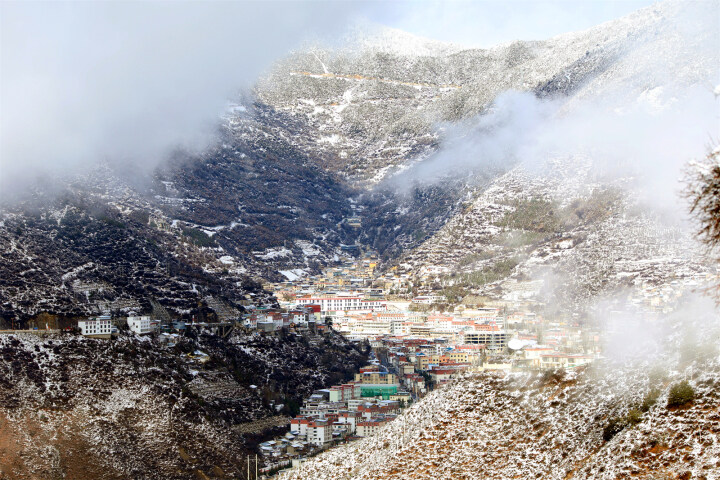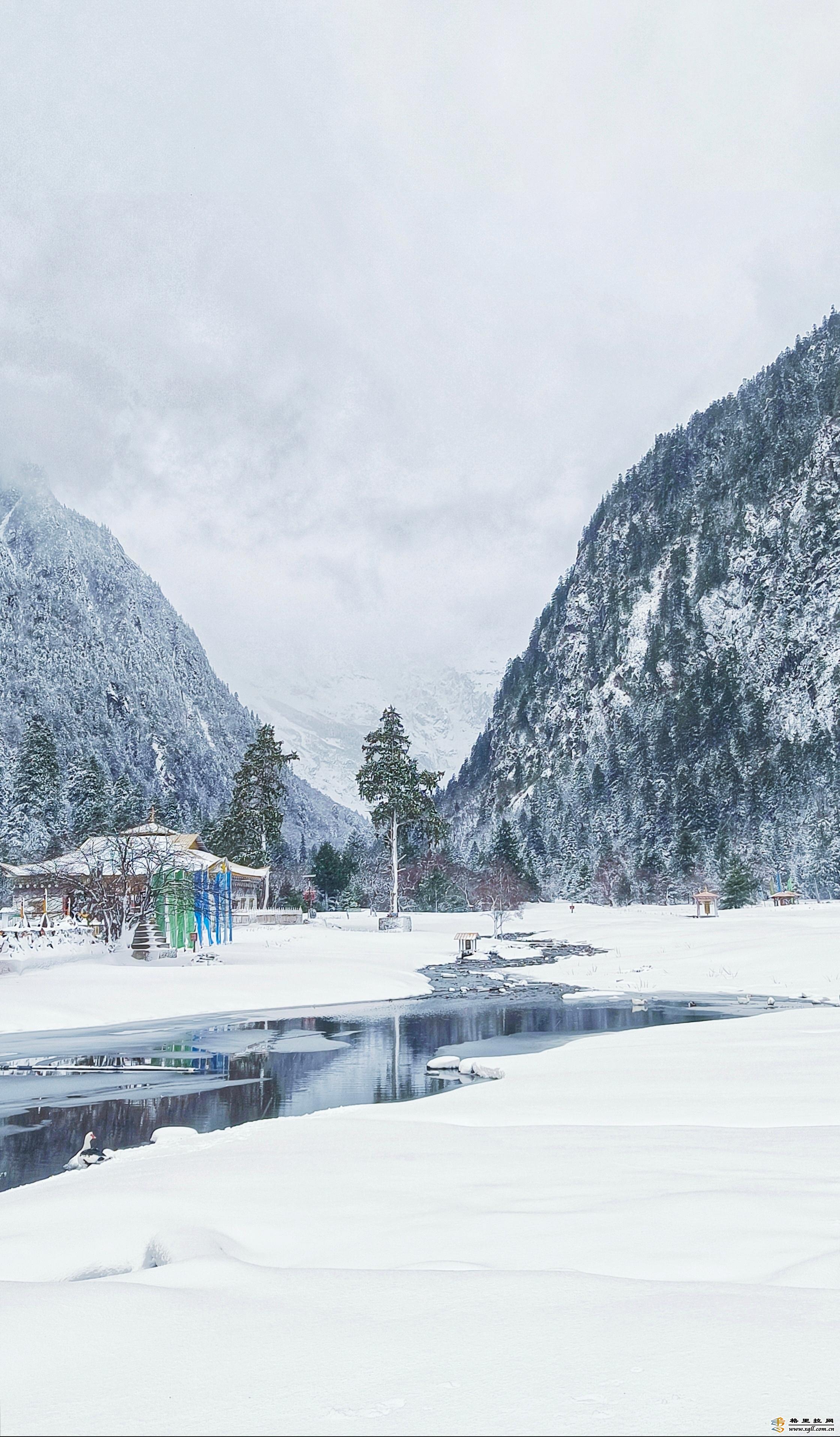Original title: Xinhua Headlines: New Tibet, the rising "Roof of the World"
-- Seventy years since Tibet's peaceful liberation in 1951, a new modern socialist Tibet that is united, prosperous, culturally advanced, harmonious and beautiful is taking shape, underpinned by sustained stability and rapid development. -- The region has enjoyed unprecedented population growth and cultural blossoming, freedom of practicing religions, more job and business opportunities, better ecological environment and more infrastructure spending. -- Two American experts on a fact-finding mission to acquire firsthand experience of the lives of everyday Tibetans, local socioeconomic development, and the real face of new Tibet! by Xinhua writers Luo Bo, Miao Xiaojuan and Ma Yunfei
LHASA, July 28 (Xinhua) -- There are very few places on this earth where humanity can transcend the boundaries of race and nationality, where one can go beyond the human perspective and understand that we are one with the universe. Tibet is one such destination. "There's natural beauty around the world, but Tibet is an example of real natural beauty," said American economist David Blair. "It's great to have an opportunity to see." "It's very spiritual," said Shaun Rein, another American expat living in China and founder of a Shanghai-based market research firm. Invited by Xinhua's China Chat show, Blair and Rein spent a week in southwest China's Tibet Autonomous Region on a fact-finding mission to acquire firsthand experience of the lives of everyday Tibetans, local socioeconomic development, and the real face of new Tibet, possibly one of the most misunderstood places in the world.  American economist David Blair (1st L), Xinhua journalist Miao Xiaojuan (C) and Shaun Rein, American expat living in China and founder of a Shanghai-based market research firm, chat at Barkhor Street in Lhasa, southwest China's Tibet Autonomous Region, May 19, 2021. (Xinhua/Xu Yongzheng) American economist David Blair (1st L), Xinhua journalist Miao Xiaojuan (C) and Shaun Rein, American expat living in China and founder of a Shanghai-based market research firm, chat at Barkhor Street in Lhasa, southwest China's Tibet Autonomous Region, May 19, 2021. (Xinhua/Xu Yongzheng)
This year marks the 70th anniversary of the peaceful liberation of Tibet. On May 23, 1951, the central government of the People's Republic of China, then still in its infancy, signed an agreement with the local government of Tibet on the peaceful liberation of the region, helping the people of Tibet break free from the fetters of imperialist invaders for good. A subsequent democratic reform in the late 1950s abolished theocracy and feudal serfdom in Tibet. The 14th Dalai Lama, clinging jealously to the system of serfdom and slavery that dominated old Tibet, fled China in the wake of a failed coup to resist the reform. These great changes, as noted in the late American journalist Israel Epstein's 1983 book Tibet Transformed, "were profoundly emancipatory, physically and mentally, for the overwhelming majority of Tibetans." With strong support from the central government and the rest of China, and boosted by the great endeavors of people of all ethnic groups in the region, Tibet is catching up with other parts of the country in terms of socioeconomic development. A new modern socialist Tibet that is united, prosperous, culturally advanced, harmonious and beautiful is taking shape, underpinned by sustained stability and rapid development. CONNECTIVITY: ROADS, INTERNET AND INFRASTRUCTURE Having lived in China for most of the past 24 years and having first traveled to Tibet in 2001, Shaun Rein, founder and managing director of China Market Research Group, had feared his return to the region would be a journey back in time to the Tibet of old, to a region left behind by the rest of the country. "Tibet was so poor when I came here the first time," Rein said, recalling long bumpy journeys along winding dirt roads that left him clutching for a barf bag. Before his return to Tibet, Rein planned for the worst and told his team they would probably not be able to reach him due to a lack of access to phone or Internet. Yet Rein was in for a pleasant surprise. Today, fast highways connect the capital city of Lhasa to other smaller cities throughout the region, while cell phone towers dot the landscape providing incredible Internet speeds. Rein was shocked by the changes in Tibet's transport sector over the last 20 years, even if they paled in comparison to those witnessed by Epstein as he took a grinding 12-day trip by jeep and truck convoy from Chengdu in Sichuan Province to Lhasa in 1955. "Even that seemed wonderfully speedy then," Epstein wrote, recalling his first visit to Tibet in his book. "For thousands of years in the past, the only transport had been by yak or mule caravan -- six months being considered good time for the trip." Since 1951, Tibet has gradually built a comprehensive transport network composed of highways, railways and air routes. 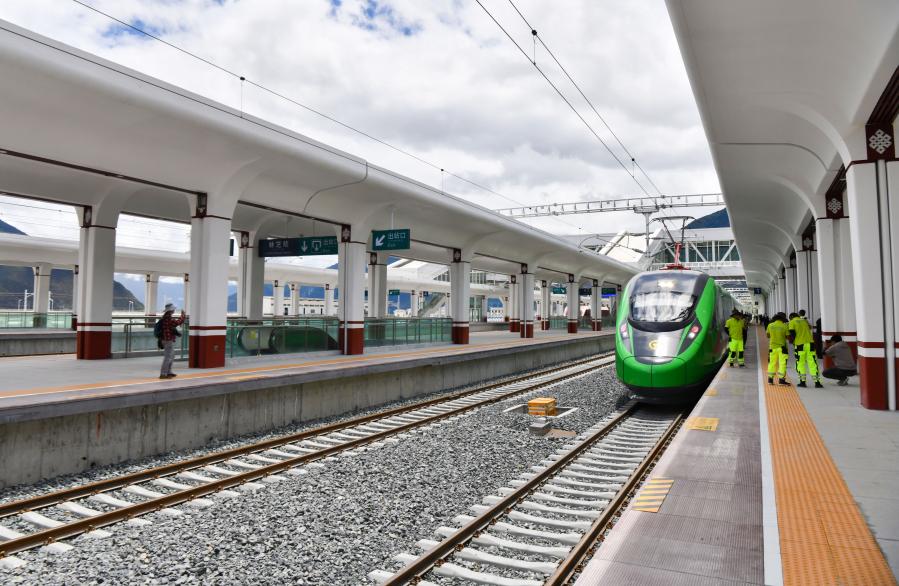 The Fuxing bullet train of the Lhasa-Nyingchi railway arrives in Nyingchi, southwest China's Tibet Autonomous Region, June 25, 2021. (Xinhua/Jigme Dorje) The Fuxing bullet train of the Lhasa-Nyingchi railway arrives in Nyingchi, southwest China's Tibet Autonomous Region, June 25, 2021. (Xinhua/Jigme Dorje)
According to a white paper issued by China's State Council Information Office in May, 118,800 km of highways have been built, providing access to all administrative villages in the region. Ninety-four percent of towns and 76 percent of administrative villages now have direct access to asphalt and concrete roads. Building and fixing roads in Tibet can be very costly, and many of the roads are underused due to the low population density in more remote parts of the region, according to Dong Gengyun, a Beijing official who has been sent to Lhasa on a three-year assignment to support Tibet's development. "But we have to do it, because we're not here for sightseeing, but to help develop the local economy and improve people's livelihoods," Dong said. David Blair, vice president and senior economist at the Beijing-based Center for China and Globalization, regards infrastructure spending as critical because it allows people to run businesses. In Tibet, he saw people setting up B&Bs and even innovation centers. "In many remote areas of the United States, you cannot get high-speed Internet either by wireless or wired network, and there's no incentive to provide it," Blair said, amazed by the "great 4G connectivity in a little village in the middle of Tibet." OPPORTUNITY: TEENS, PILGRIMS AND ENTREPRENEURS There was not a single school in the modern sense of the word in old Tibet. The illiteracy rate exceeded 95 percent, to say nothing of the complete lack of understanding of modern science and technology. Founded in 1956 with only 20 to 30 students, Lhasa Middle School in the downtown area of the city is the first modern and standard middle school in the history of Tibet. At present, the school has some 3,000 students, with Tibetan students accounting for about 62 percent, said Tang Yong, the school's principal, adding that most of the students aspire to one day attend college. From 1951 to 2020, the central government invested 224 billion yuan (about 35 billion U.S. dollars) in Tibet's education. Now, the region has established a modern educational system which includes preschool, primary and middle schools, vocational and technical schools, institutions of higher learning, and special education institutions. According to Gong Xiaotang, Party secretary of the Lhasa No. 2 Secondary Vocational School, Tibet has taken the lead in China in providing students with 15 years of publicly funded compulsory education. Students at the vocational school have a wide variety of courses to choose from, including cooking, traditional Tibetan clothing and medicine production, thangka painting, and other disciplines. The school is also teaching hotel management, accounting, advertisement design and drone operation. 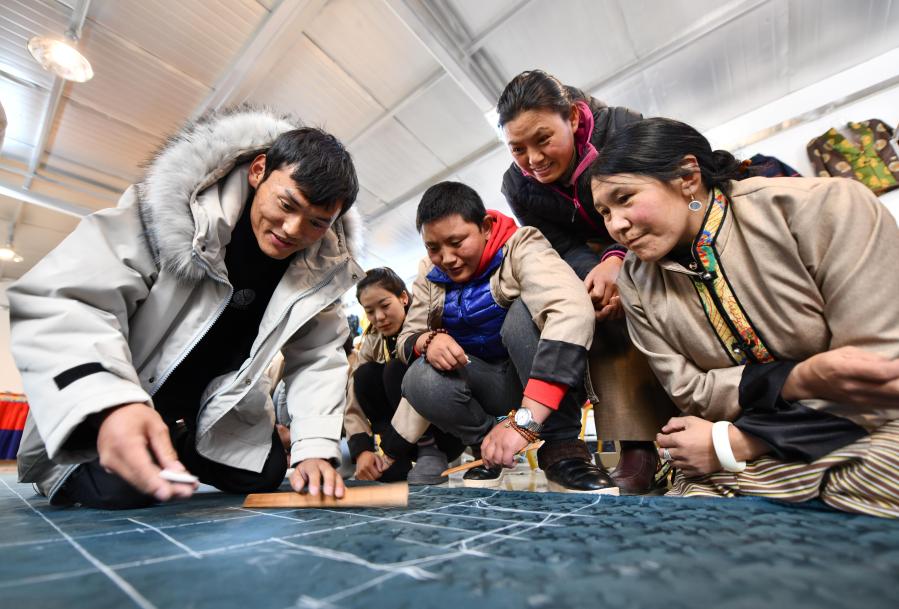 Students learn tailoring techniques at a vocational school in Lhasa, capital of southwest China's Tibet Autonomous Region, Nov. 23, 2020. (Xinhua/Jigme Dorje) Students learn tailoring techniques at a vocational school in Lhasa, capital of southwest China's Tibet Autonomous Region, Nov. 23, 2020. (Xinhua/Jigme Dorje)
"I was impressed by the kids. They were learning a skill that was going to make them money, and they seem to understand that at a very young age," Blair said. "And I was amazingly impressed by how much these kids knew, how hardworking they were, and how dedicated they are to building their own futures." The American economist was also struck by a maker's center in Lunang, Nyingchi City, where primary students are taught to use computers and 3D printers. "They're creating a spirit of dynamism in the young kids, and that's going to pay off," Blair said, noting that the youngsters will grow up dreaming of being innovators, building businesses and taking advantage of economic opportunities. Barkhor Street, which circles the Jokhang Temple, a UNESCO World Heritage site and part of the historic ensemble of the Potala Palace, is the most famous pilgrim circuit in Lhasa and is always packed with pilgrims from across the region. The faithful complete the circuit clockwise, spinning their prayer wheels in the same direction. There are more than 1,700 sites for Tibetan Buddhist activities with 46,000 monks and nuns in Tibet, while traditional religious activities are carried out regularly in accordance with the law. Every year, large sums of money are spent by the government on the renovation and maintenance of the Potala Palace to ensure that the pilgrims have a safe environment where they can practice their religion, according to Jorden, director of the administrative office of the Potala Palace. 
A worker paints the wall of the Potala Palace during an annual renovation of the ancient architectural complex in Lhasa, capital of southwest China's Tibet Autonomous Region, Oct. 28, 2020. (Xinhua/Purbu Zhaxi)
"We saw many people still retain their religious ideals, while at the same time, they don't want to be poor because of that," Blair said. This sentiment was echoed by Rein, who found that the religious beliefs of Tibetan locals have proven no obstacle to bringing about economic prosperity. "I don't think there's a disconnection or conflict between the two." In 2020, the per capita disposable income of people in Tibet was double the figure from 2010. The average per capita disposable income of rural residents enjoyed double-digit growth over the past 18 years, while that of urban residents in 2020 reached 41,156 yuan, a year-on-year increase of 10 percent. Rein believed the most impressive part of the trip was seeing the rise of the middle class in Tibet, as a growing number of locals bid farewell to poverty. "When you have a vibrant middle class, you have a vibrant, sustainable and successful society," he said. The Tibet Yougecang Enterprise, a Tibetan incense producer with fewer than 60 employees, has received a 50-million-yuan line of credit from the Agricultural Bank of China, according to Dawa, the enterprise's deputy general manager. Having seen the implementation of Beijing's policy supporting small businesses and encouraging mass entrepreneurship in Tibet, Rein and Blair were optimistic about the future development of the region as well as the Chinese economy. However, finding a viable business model remains the greatest challenge for Tibet, so that the region can ultimately wean itself off support from the rest of the country, Blair noted. REALITY: A FAREWELL TO LIES AND SLANDER While Epstein wrote of a rekindled enthusiasm and passion for life among ordinary Tibetans since the democratic reform, Rein and Blair observed a Tibet far removed from its portrayal in Western media. Rein and Blair saw for themselves the bilingual signs and software used by doctors to write out diagnoses for patients at the Tibetan Medicine Hospital of Tibet Autonomous Region, as well as students learning Tibetan language in a classroom in Lhasa Middle School. "It was very clear that the government is doing a pretty good job at protecting Tibetan culture and Tibetan language," Rein said, adding that he was upset with the baseless accusations made by former U.S. Secretary of State Mike Pompeo and his successor Antony Blinken. "I don't like the false narrative that Blinken is perpetuating after Pompeo, which a lot of U.S. media are talking about simply because China wants to create a unified, patriotic country," Rein said. The term also bothered Blair, who mentioned that such grave accusations should not be made so lightly. "I don't think there's anything like that going on, so we should take that term off the table," he said. The population of Tibet has increased from 1.23 million in 1959 to 3.5 million in 2019, with ethnic Tibetan people accounting for over 90 percent of the region's total. The average life expectancy in Tibet reached a record high of 71.1 in 2020, double the figure from 1951. 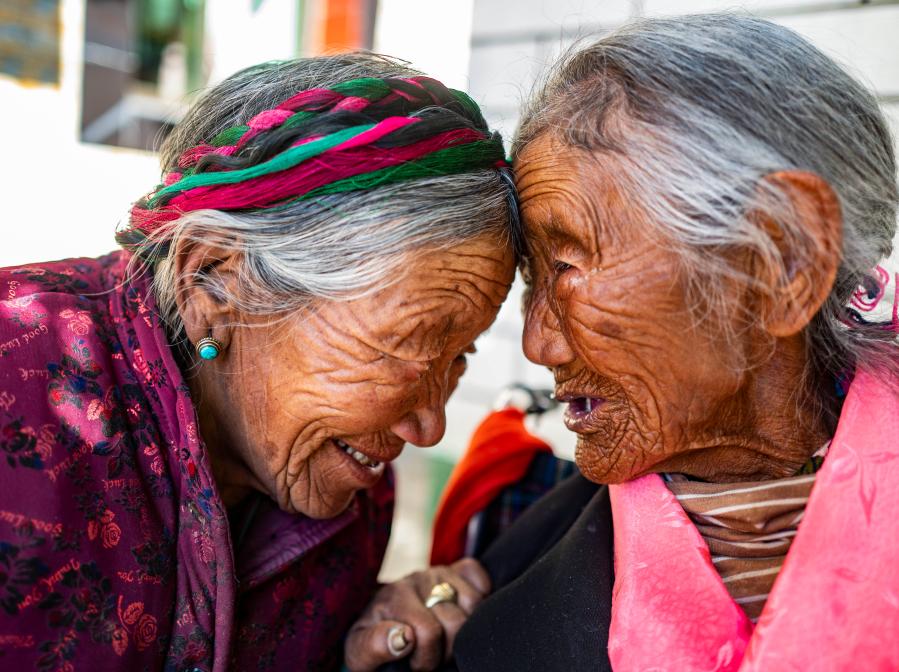
Sonam Drolma (R) interacts with her sister in Reguo Village of Gyaca County in Shannan, southwest China's Tibet Autonomous Region, March 24, 2020. (Xinhua/Purbu Zhaxi)
China attaches great importance to the protection and development of traditional Tibetan culture, with the study and use of the Tibetan language protected by law. The region now has 16 periodicals and 12 newspapers in the Tibetan language, and has published more than 40 million copies of 7,185 Tibetan-language books. In addition, the language is widely used in the sectors of health, postal services, communications, transport, finance, and science and technology. The disconnect between the region's flourishing cultural scene and its depiction in Western circles was described by Albert Ettinger, a Tibet researcher from Luxembourg, in his 2015 book Battleground Tibet as "stories from wonderland." These tall tales seek to conflate unprecedented population growth with "genocide" and a cultural renaissance with "cultural genocide." Rein and Blair also found that younger Tibetans seem to be the most optimistic of all the different segments of society, thanks to the great advancements made in the quality of life of locals. As the first two foreigners to visit the Zam Hydropower Station along the Yarlung Zangbo River, the largest plant of its kind in Tibet, they were glad to see the balance struck between development and environmental protection. 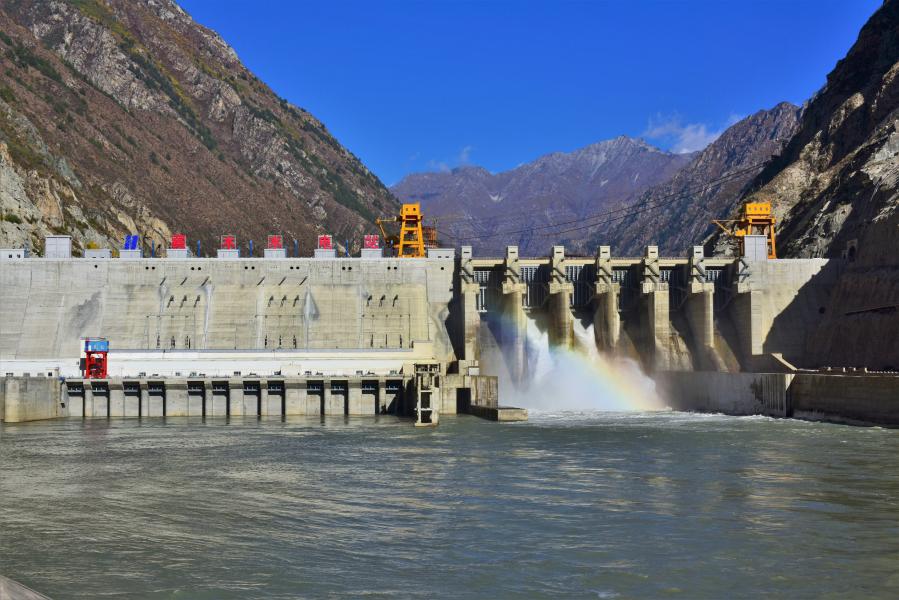
File photo taken on Oct. 22, 2018 shows the Zam Hydropower Station in southwest China's Tibet Autonomous Region. (Photo by Dong Zhixiong/Xinhua)
The hydropower plant currently provides 30 percent to 35 percent of Tibet's energy needs, saving some 400,000 tonnes of diesel oil every year, according to Liu Feng, who is in charge of its operation. In addition, hundreds of millions of yuan has been spent to ensure fish can safely bypass the facility and swim back upstream.
"If people's livelihoods are to be improved, the region needs to have sufficient electricity," Liu said. "People should not demonize the utilization of hydroelectric energy."
Since 1978 when China started its reform and opening-up push, the Communist Party of China Central Committee has held seven national meetings on Tibet, making major decisions and plans for the region.
China began to provide pairing-up support for Tibet in 1994, with central government departments, other provinces and equivalent administrative units along with centrally administered state-owned enterprises offering paired assistance through 6,330 projects, representing a total investment of 52.7 billion yuan by 2020. A total of 9,682 outstanding officials were selected and dispatched to assist the region during the period. According to Rein, these policies show that the whole country has been trying to progress and work together to build a strong China. "You don't see, say in the United States, where a wealthy state like California is sending some of their tax money to poor states like West Virginia," he said. "And that's why they are falling further and further behind under the income level."
In comparison, China, Rein noted, "doesn't want to leave any provinces behind."
(Xinhua correspondents Han Xile and Bai Shaobo also contributed to the story.)
Source: Xinhua
|











7740f3b5-9ecb-438e-9052-76cb2d4bb671.jpg)
